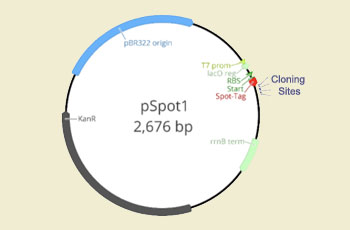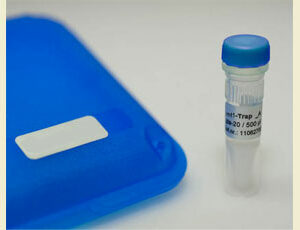These 12 amino acids will make all the difference
The Spot-Tag Fusion Protein System is the first “create-your-own” peptide-tag specifically designed for use with the “nanobody” suite of products. Nanobodies are small, high-performance fragments of monoclonal antibodies that show superior performance across a wide range of detection, purification, and imaging applications. This connection allows any lab to easily construct and express a single Spot-Tag fusion protein, which can then be used with any of our capture or detection applications. For example, the Spot-Trap Affinity Reagents can be used to purify any Spot-Tagged protein in a single step, whether by a simple immunoprecipitation or by ultrapure affinity purification–even under gentle conditions that preserve protein function. The same Spot-Tagged protein can also be detected with the tiny and rugged Spot-Label, which will specifically bind for ultra-sensitive Western blotting, ultra-bright immunofluorescence, or even super-resolution microscopy.

The Spot-Tag system is fully validated! The Spot-Tag sequence is: PDRVRAVSHWSS. It’s just 1.4kDa, and can easily be placed at either the C-terminus or the N-terminus without impacting your target protein’s function. In practical experiments, it has proven to be completely inert, easy to clone, and to have robust levels of expression in bacteria, yeast, mammalian, and insect cell lines. The Spot-Nanobody’s sequence and structure are known as well; its binding mechanism with Spot-Tag has been elucidated. Spot-Nanobody is produced recombinantly for consistently high quality. Precise production guarantees performance no matter the configuration: affinity purification (Spot-Trap), immunoprecipitation (Spot-Trap), Westerns (Spot-Label monovalent form), and immunofluorescence (Spot-Label divalent form) are all possible.
Spot advantages compared to Flag
More robust & stable
Higher affinity
Less background
Higher resolution
Less negatively charged
Shorter than other tags
Less nonspecific binding
Inert
N-terminus and C-terminus
Codon optimized sequences for Spot-Tag:
E. coli: CCGGATCGCGTGCGCGCAGTCTCTCACTGGAGCAGC S. cerevisiae: CCAGATAGAGTTAGAGCTGTTTCTCATTGGTCTTCT
Human cell line: CCAGACCGCGTGCGCGCCGTGAGCCATTGGAGCAGC
Optional Linker
We recommend a short Gly-Ser linker, if there are adjacent acidic amino acids (Glu/Asp):
E. coli: GGTTCT
S. cerevisiae: GGTTCT
Human cell line: GGCAGC
Spot vectors for cloning
| Vector | Data- sheet | Sequence file |
|---|---|---|
| pSpot1 vector, E. coli, Spot-tag N-term., Kan., high expression | ev-1.pdf | ev-1.gb |
| pSpot2 vector, E. coli, Spot-tag C-term., Kan., high expression | ev-2.pdf | ev-2.gb |
| pSpot3 vector, E. coli, Spot-tag C-term., Amp., low expression | ev-3.pdf | ev-3.gb |
| pSpot4 vector, E. coli, Spot-tag N-term., Amp., low expression | ev-4.pdf | ev-4.gb |
| pSpot5 vector, S. cerevisiae, Spot-tag N-term., Leu, CEN, low expression | ev-5.pdf | ev-5.gb |
| pSpot6 vector, S. cerevisiae, Spot-tag C-term., Leu, CEN, low expression | ev-6.pdf | ev-6.gb |
| pSpot7 vector, S. cerevisiae, Spot-tag N-term., Leu, 2µ, high expression | ev-7.pdf | ev-7.gb |
| pSpot8 vector, S. cerevisiae, Spot-tag C-term., Leu, 2µ, high expression | ev-8.pdf | ev-8.gb |
Spot-Tag Vectors

pSpot1 – Plasmid vector, E. coli, Spot-tag N-term., Kan., high expression, 1.25 µg
$65.00 Add to cart
pSpot2 – Plasmid vector, E. coli, Spot-tag C-term., Kan., high expression, 1.25 µg
$65.00 Add to cart
pSpot3 – Plasmid vector, E. coli, Spot-tag C-term., Amp., low expression, 1.25 µg
$65.00 Add to cart
pSpot4 – Plasmid vector, E. coli, Spot-tag N-term., Amp., low expression, 1.25 µg
$65.00 Add to cart
pSpot5 – Plasmid vector, S. cerevisiae, Spot-tag N-term., Leu, CEN, low expression, 1.25 µg
$65.00 Add to cartSpot peptide
|
SPECIFICATIONS
|
|
|---|---|
| Configuration: | DNA Plasmid |
| Amount: | 1.25 µg |
| Expression Level: | High and low expression plasmids available |
| Resistance: | Kan, Amp, & Leu avaiable |
| Spot-Tag Amini Acid Sequence: | PDRVRAVSHWSS |
| Part Numbers | pSpot1, pSpot2, pSpot3, pSpot4, pSpot5, pSpot6, pSpot7, pSpot8, EP1 |
| Storage: | store at -20°C |


